The seeds of change sown by Ratnagiri’s tiny coastal village to protect its turtles has led to a first-of-its-kind satellite-tagging effort along the entire western coast that’ll shine light on the migratory patterns of the Olive Ridley
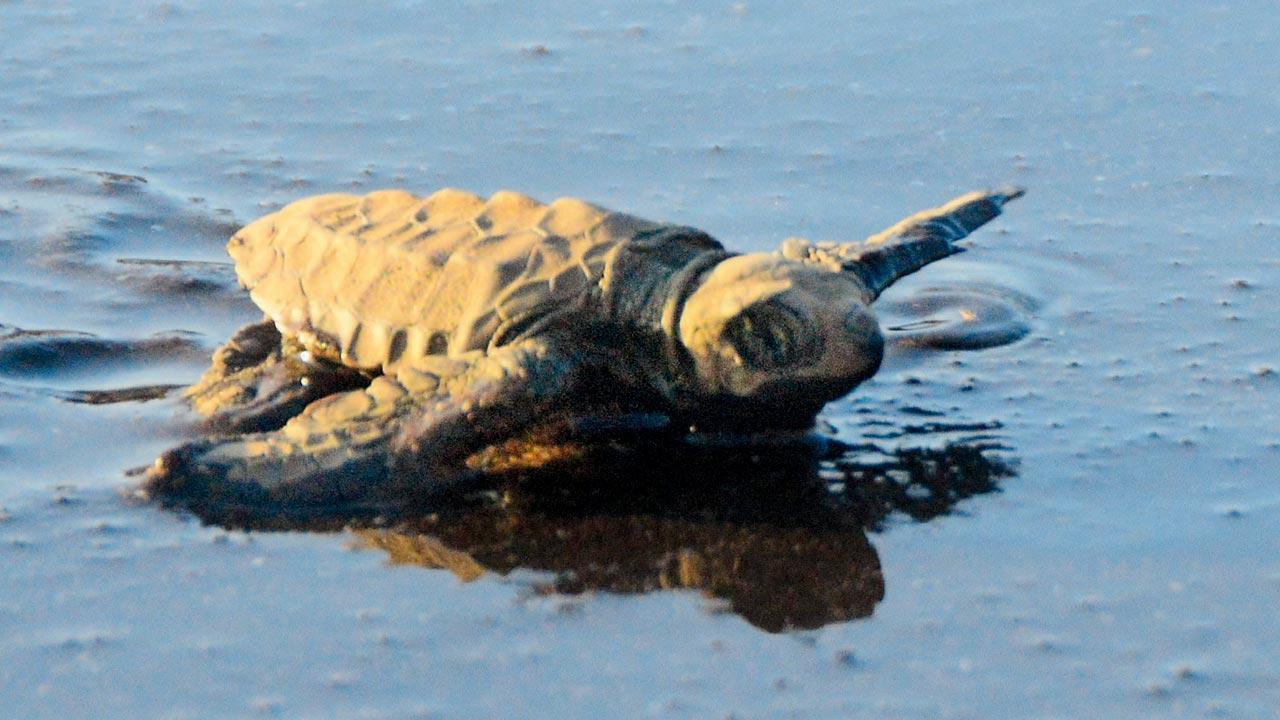
Tiny Olive Ridley hatchlings make their way towards the sea, early in the morning at Velas beach in the Mandangad taluka of Ratnagiri. The babies are often attacked by crabs or large fish in the sea. Pics/Satej Shinde
Nestled between a secluded beach on one side and picturesque mountains on the other, the coastal village of Velas in Mandangad Taluka of Ratnagiri district, wakes up before dawn. At 5 am on a sluggish March weekend, a group of visitors throng the beach for a rare spectacle. As the salty sea breeze blows, tiny turtle hatchlings emerge from beneath layers of sand. With the sea glistening in the early morning sun, the hatchlings follow the light. They crawl towards the waters, amidst cheers from an expectant crowd.
There was a time when turtle eggs were a meal-time delicacy for the villagers. Today, the 225 families that live here are the frontrunners of turtle conservation efforts in Maharashtra, and the force behind the annual Velas Turtle Festival. Every March, when the turtles come to the beach to prepare for hatching, the festival draws in tourists who are hosted at homestays and guided by the villagers, who share stories with them about the importance of protecting the Olive Ridley turtles, a species found in the tropical waters of the Pacific, Atlantic and Indian oceans, and gets its name thanks to the colour of the heart-shaped shell. It has given them a steady source of income. Ownership of the species they cohabit the village with means that the villagers don’t allow sand activity or water sports at Velas beach. Tourist must walk close to 10 minutes to get to the shore to witness the conservation effort at the artificial pits.
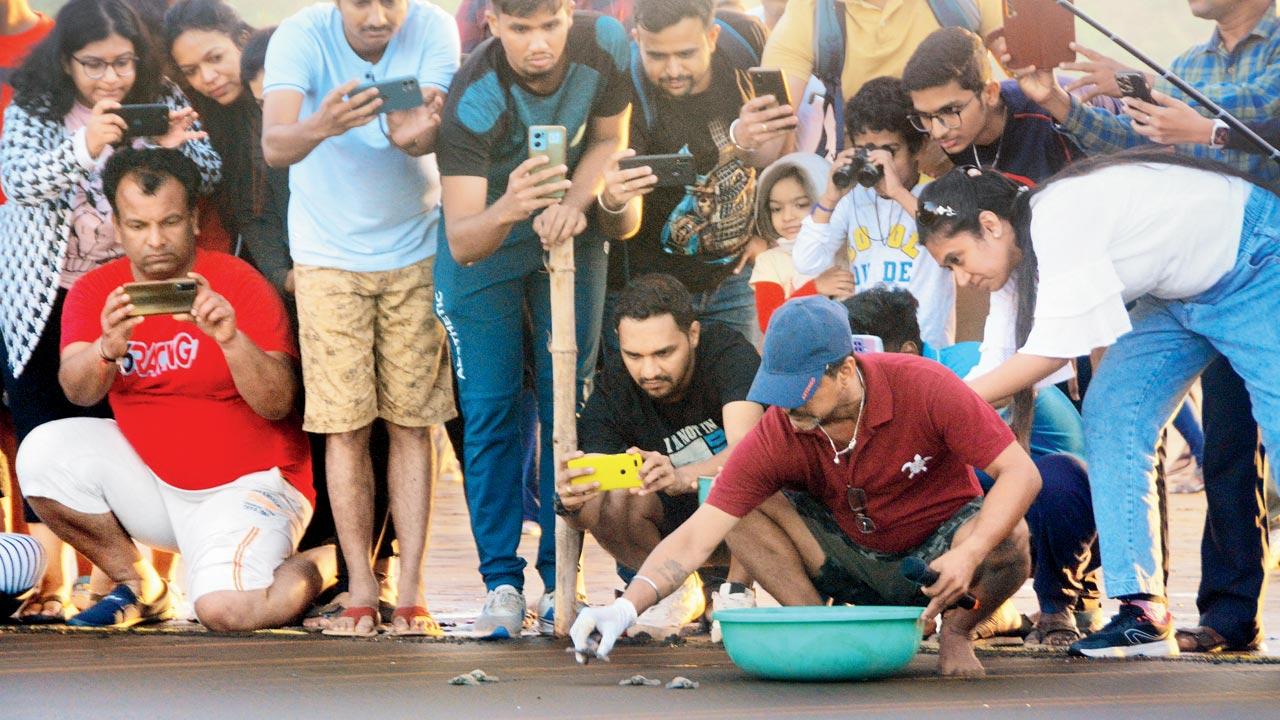
“Turtle conservation in Velas began as recently as 20 years ago,” says local resident Mohan Upadhyay. The seeds for the project were sown in 2002, when members of the Sahyadri Nisarg Mitra, a Chiplun-based non-profit, visited the village for a survey of the white-bellied sea eagle nests. “While roaming the beach, the team spotted empty turtle egg shells. They enquired with the locals, but weren’t able to get any information,” remembers Upadhyay.
One of the residents, Gopinath Mhadik, eventually came forward and informed the NGO staff that the eggs belonged to female turtles that would migrate to Velas to nest. “He narrated how villagers would scout for turtle eggs and cook them on a chulha outside their home, and enter only after bathing. It was a ritual of sorts.” Since the eggs were found in plenty, and because they were rich in protein, they’d also become fodder for the bullocks right before the bull race during Diwali. “A female turtle would lay between 100 and 150 eggs at a time. The villagers would sell what they didn’t consume in nearby villages to help them earn extra income.”
 Tourists attending the Velas Turtle Festival watch hatchlings being released into the sea
Tourists attending the Velas Turtle Festival watch hatchlings being released into the sea
The eggs, the NGO would learn, belonged to the Olive Ridley sea turtle, a marine species that is legally protected under Schedule I of the Wildlife Protection Act, 1972 and Appendix I of the CITES Convention, which prohibits trade in turtle products. “Locals,” says Upadhyay, “were unaware of the turtle’s protected status. The non-profit steered a meeting with the gram panchayat to acquaint the villagers with the urgency for conservation.
Upadhyay, then 24, had just quit his job as a clerk at a private firm in Mumbai, and returned home. “I was fed up with the hectic life and wanted to do something different here [in Velas],” he says.
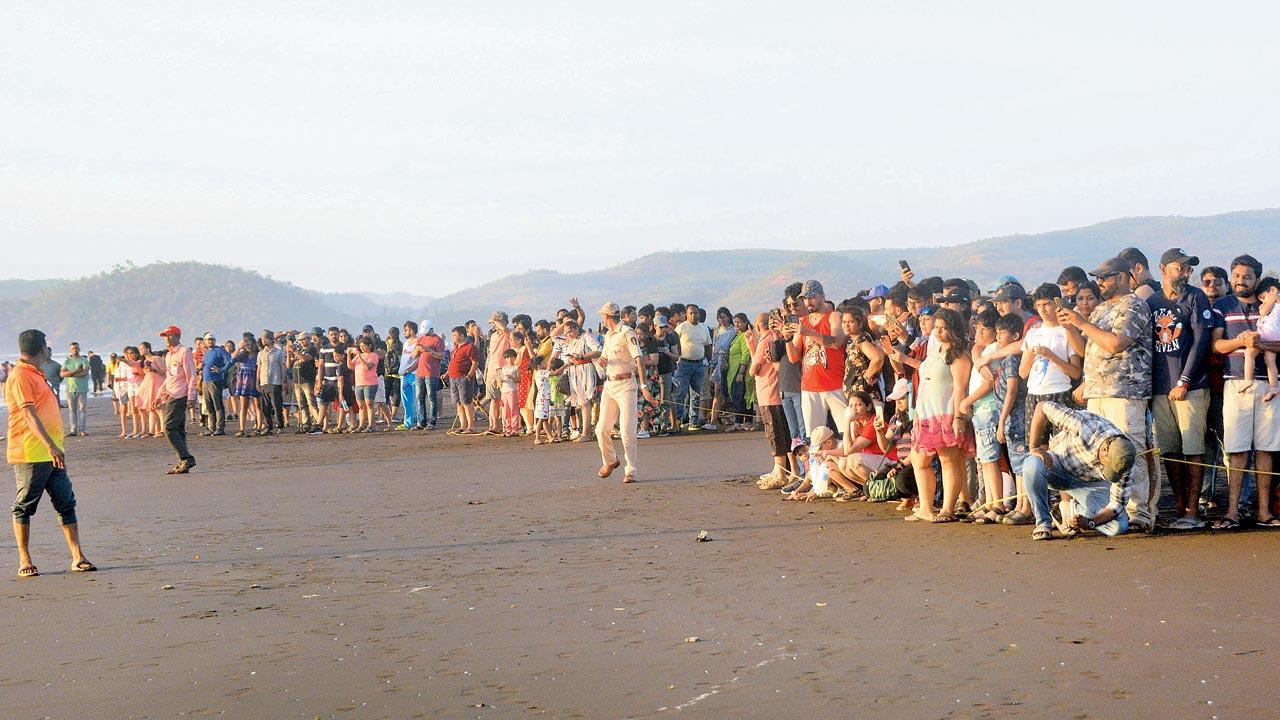
In 2003, sometime during the beginning of the nesting season in November, Upadhyay was approached by Bhau Katdhare, president of Sahyadri Nisarg Mitra. “He asked if I would join the efforts to save the turtle,” recalls Upadhyay, now 45. “Until then, I had never seen the turtles, even though they would nest close to my hamlet.”
Today, Upadhyay is considered a turtle conservation expert. It’s the work of locals like him, which has paved the way for similar efforts on others beaches along Maharashtra’s coast. Volunteers from the village are trained by the forest department in how to extract eggs from the sand nests and release the hatchlings into the sea, and offered a monthly stipend.
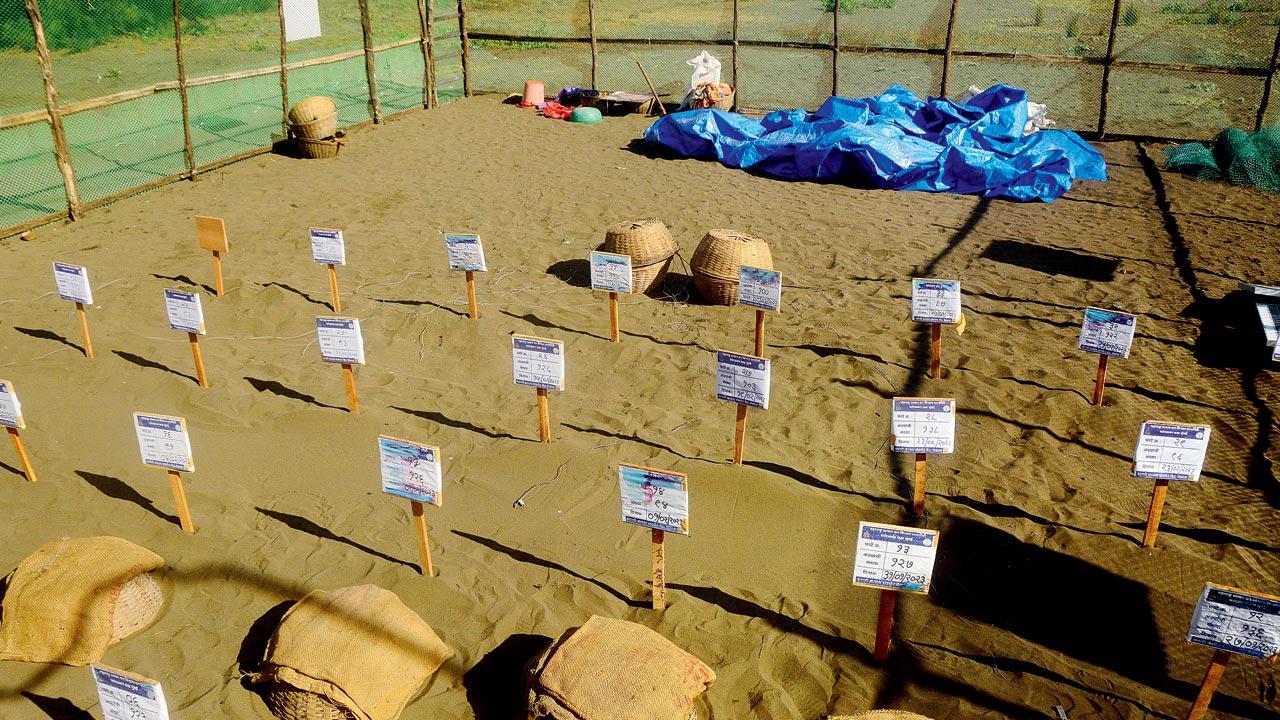 To protect the eggs from predators, they are safely removed from the nesting sites, and transported to hatcheries or artificial pits made on the beach. The eggs are then covered with sand, and a basket is placed above the pit for additional protection. The nesting site is also barricaded from all sides
To protect the eggs from predators, they are safely removed from the nesting sites, and transported to hatcheries or artificial pits made on the beach. The eggs are then covered with sand, and a basket is placed above the pit for additional protection. The nesting site is also barricaded from all sides
Last year, the Mangrove Cell of the forest department launched a first-of-its-kind exercise in the state, fitting seven Olive Ridley turtles with satellite devices. These are now offering information on the navigation patterns of the majestic creature.
Female Olive Ridley turtles, travelling to the shore to lay eggs, not only face threat from humans, but even predators, including stray dogs, wild boars, and jackals. The female turtle comes to the shore once a year around November-December; it uses its back flipper to dig nests in the sand. She leaves immediately after laying the eggs. These predators attack the nests in her absence, digging out the sand. The mother turtle covers the nest with sand because it is essential for the egg incubation. When the nest is left open by the predators, the other eggs risk being destroyed too.
 Upadhyay and fellow villagers conduct an awareness session on Olive Ridley turtles for visitors at Velas
Upadhyay and fellow villagers conduct an awareness session on Olive Ridley turtles for visitors at Velas
Turtle eggs have an incubation period of between 45 and 55 days during the summers or 60 to 65 days in winter.
The villagers of Velas have been trained by the forest department to safely remove the eggs from the nesting sites, and transport them to hatcheries or artificial pits made on the beach. Once the eggs are moved, they are covered with sand; a basket is placed above the pit for additional protection. A number is assigned to each pit, as part of the monitoring process. The nesting site is also barricaded from all sides.
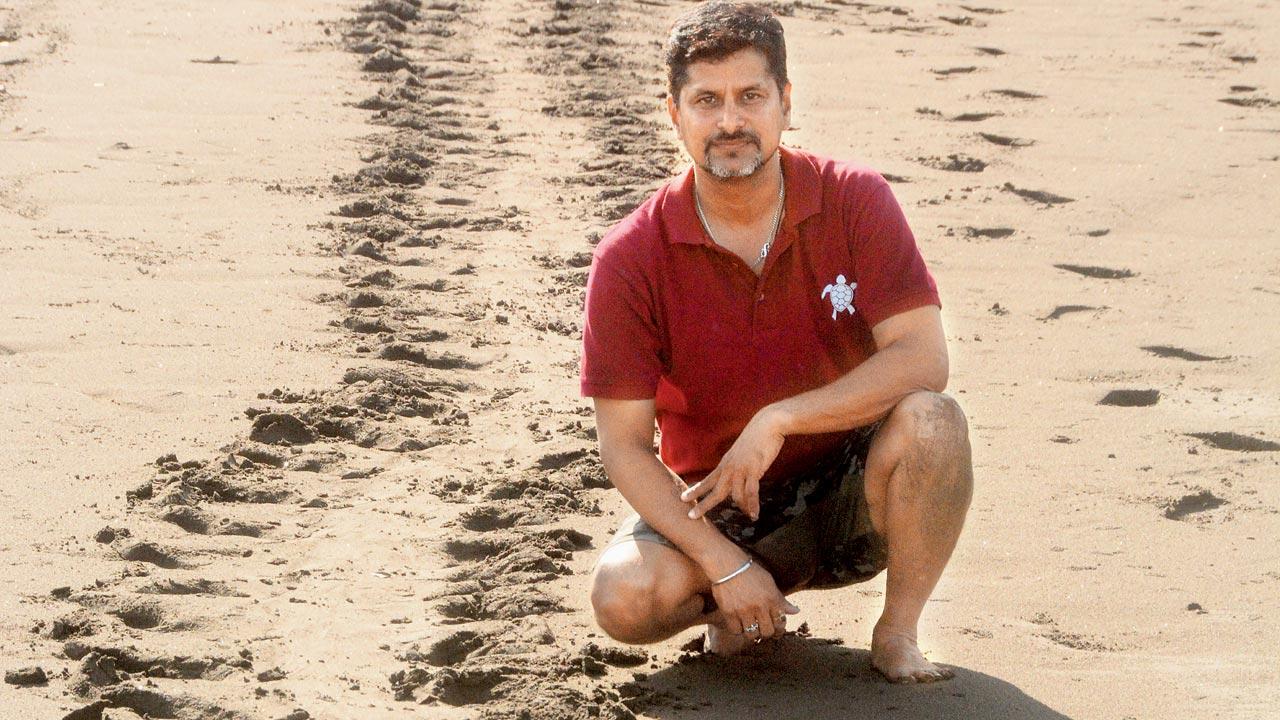 Velas resident Mohan Upadhyay, 45, has been working with the NGO Sahyadri Nisarg Mitra for the last 20 years, leading turtle conservation efforts in his village
Velas resident Mohan Upadhyay, 45, has been working with the NGO Sahyadri Nisarg Mitra for the last 20 years, leading turtle conservation efforts in his village
The problem, says Upadhyay, is that even if the nest is guarded against predators, the hatchlings are eaten by crabs, when they attempt to swim towards the sea post hatching. During daytime, they face threats from crows, Brahminy kites, and seagulls. The baby turtles are also eaten by large fish in the ocean. Throughout their lifetime, the sea turtle faces threats from fishing nets, often getting entangled and suffering injuries. Death also comes calling when they come in contact with ship propellers.
Although the state’s coast is being monitored for sea turtle nesting, information on the non-breeding areas is currently missing. Over the last one year, the Wildlife Institute of India (WII) with the support of the Mangrove Cell of the state government, has undertaken satellite tracking of seven Olive Ridley turtles—five in 2022 and two this year—with the objective of tracking the breeding and post-nesting movement. This will help provide details about their
diving behaviour.
Speaking to mid-day, Dr Manas Manjrekar, deputy director of the Mangrove Cell, says that the project has been in the works for long. “Olive Ridley sea turtles nest on the beaches of Ratnagiri, Raigad and Sindhudurg districts. The satellite-tagging was important because we didn’t know where they went after laying the eggs. We were curious about their migration movement in the sea.”
Similar studies have already been conducted on the eastern coast, in the state of Odisha. “In 2001, WII had radio-tagged Olive Ridley turtles on Devi beach. With the information it threw up, researchers got a fair idea of their migration patterns in the Bay of Bengal and the Indian Ocean.”
According to a research paper titled Movements of Olive Ridley Turtles (Lepidochelys olivacea) in the Bay of Bengal, India, Determined via Satellite Telemetry, the migratory movements of 14 Olive Ridley turtles in the Bay of Bengal were studied using satellite telemetry during 2009-2010. Tracking data showed that the turtles undertook open-ocean migrations in the Bay and “exhibited migratory corridor between foraging habitat of Sri Lanka and nesting sites along the Odisha coast of India”.
As there was no data available for turtles from the Arabian Sea and the western coast, WII decided to undertake the exercise in Maharashtra. “Last January, we satellite-tagged two turtles on the western coast of the state—the first one was tagged in Velas and named Prathama, and the second turtle was tagged at Anjarle, which is 10 km south. She was named Savani,” says Manjrekar.
Soon after, three more Olive Ridley turtles were tagged on the beach of Guhagar in Ratnagiri, between February 15 and 16, 2022. They were named Vanashree,
Reva and Laxmi.
“All the five turtles were released back into the sea and authorities received data for around four to five months regarding their movement, before the transmitters stopped working,” says Manjrekar, adding, “We had hoped that the transmitters would work for at least 10 months to a year, but technical glitches came in the way.” Whatever data they managed to receive, he says, is “important and interesting”.
Of the five turtles that were satellite-tagged, only Laxmi’s transmitter signal gave way within two to three days. Officials believe that she might have drowned after getting entangled in a fishing net.
Prathama, the turtle that was tagged in Velas, travelled about 1,450 km during the four months that she was monitored. After tagging, she first moved in the northern direction. She went till the coast of Gujarat and was there for a few days, before she turned back and headed south. “We last located her near Sindhudurg and later, in Goa,” says Manjrekar.
Similarly, Savani too had a northward trajectory, before heading south. “In the months of May and June, when we lost transmission, she was off the waters of Karnataka,” he says. Reva and Vanashree also travelled southwards, reaching the waters of Karnataka. The southern movement, he suspects, is because of the water currents, which start moving in the southern direction during the onset of the monsoon.”
Vanashree travelled for 173 days and covered a distance of 1,020 km. She showed a slight difference in behaviour from Prathama, as she was engaged more in foraging activity. This also explains why she covered a lesser distance. At the time when the team received the final transmissions, Savani and Reva were quite close. Reva also recorded the deepest dive, at 332 metres.
Speaking with mid-day, WII Director Virendra Tiwari shared that the analysis of preliminary data pointed to two types of movements. “One, they work constantly, moving continuously in one direction—this is the migratory or movement phase. The other phase sees turtles move around in the same area, but at a slower pace. This could go on for days, weeks, months... it happens when they are foraging or feeding.”
It was also observed that all the five turtles moved in the continental shelf area—the undersea boundary of a continent. “The western coast of India has a very big continental shelf, and on several occasions, Reva and Savani ventured into deeper waters.” The WII is currently analysing the data and it hopes to get more insights soon. “This programme is going to be useful for future turtle conservation activity on the west coast,” says Manjrekar. According to Tiwari, the satellite-tagging study will specifically help researchers and forest department officials to get details about where the turtles come for nesting. “The data will also help protect the said beaches and spread awareness among communities that live there. Our hope is to replicate and continue the movement started by the residents of Velas.”
1,450 km
Distance that Prathama, the turtle that was satellite tagged in Velas, travelled for during the four months that she was monitored
How satellite tagging records turtle movement
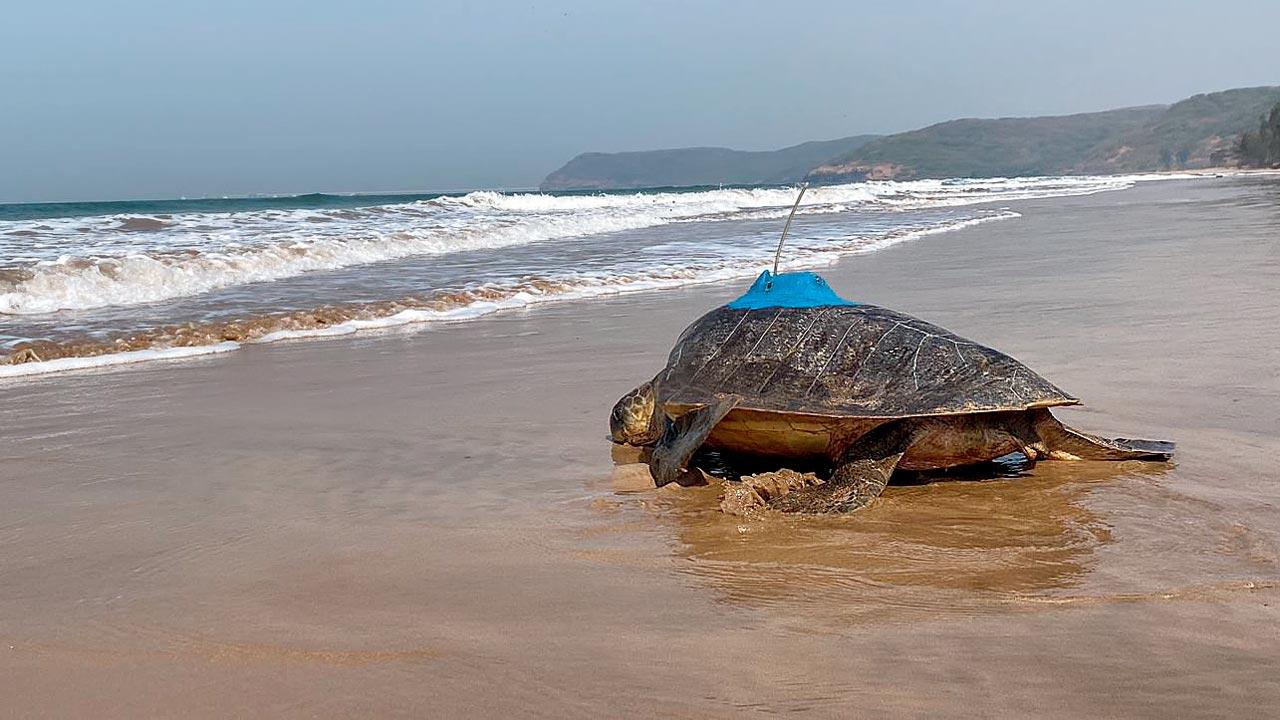 An Olive Ridley turtle that was satellite-tagged on the beach of Guhagar in Ratnagiri in February this year
An Olive Ridley turtle that was satellite-tagged on the beach of Guhagar in Ratnagiri in February this year
The satellite tags or platform transmitter terminal (PTT) devices are attached to the turtle’s carapace—the hard upper shell—with an on/off salt water switch. The switch automatically turns off when the turtle dives in, and switches on again when it comes to the surface to breathe. The transmitter connects with the Argos satellite, which then passes the information to the ground station. From there, the information is forwarded to the servers, where it is accessible to the scientists at the WII. The data is then transformed using a software, and the map is plotted to reveal the turtle’s movement pattern.
 Subscribe today by clicking the link and stay updated with the latest news!" Click here!
Subscribe today by clicking the link and stay updated with the latest news!" Click here!








